Yeast is an amazing micro-organism and watching it in action you can see why early man and indeed later generations viewed it as a mystical and magical phenomenon. Louis Pasteur was the first to identify that yeast caused fermentation in the 1860s but there had been other research before this by Charles Cagniard-Latour, Friedrich Traugott Kützing and Theodor Schwann in the 1830s and they all concluded that yeast was a living organism, before this scientists considered it to be a chemical.
Yeast is a part of the Fungi kingdom and has existed for millions of years it’s connection with humans is thousands of years old and it is thought that it is responsible for modern society as beer encouraged early humans to cultivate the land. Yeast has been nurtured by humans over the years and treasured for it’s apparently magical properties, today there are hundreds of different varieties that are used for different beers as each has an identity of it’s own which produces certain characteristics in a beer. There are two different kinds of brewer’s yeasts top fermenting and bottom fermenting, the former is used for ales and the latter for lagers. Each one ferments at a different temperature range and each one is crucial for producing the specific beer style. Bottom fermenting yeasts are capable of fermenting at low temperatures between 7 and 15 degrees and were first used in Bavaria. Top fermenting yeasts ferment between 10 and 25 degrees and have a variety of characteristics for example yeasts from Britain have a variety of different flavours that they can add to beer from fruity to spicy to woody.
Belgium has the most variety in yeast strains with different ones producing a variety of different flavours. Generally they ferment at normal brewing temperatures between 16 and 20 degrees and are extremely efficient at eating their way through all the fermentable sugars in a wort. Lambic beers are often fermented with wild yeast, the wort is left exposed to the air and is then stored in wooden barrels where other vital yeasts aid fermentation. This is what gives Lambic beer it’s distinctive flavour, although this fermenting process cannot be done during the summer months as there are too many nasties in the air at this point.
There are a number of different yeasts used in beer brewing here are the two most popular:
Saccharomyces cerevisiae (Ale Yeast):
Commonly known as ale yeast and is top fermenting working at temperatures above 16 degrees, some strains have been known to go lower but anything under 13 degrees will cause the yeast to go dormant. It is generally best to brew between 18 and 20 degrees with as little fluctuation as possible to get the best performance from the yeast. It is the most widely studied organism in molecular and cell biology. There is a wide variety of ale yeast available that impart different flavours. Here are a few examples of what we stock: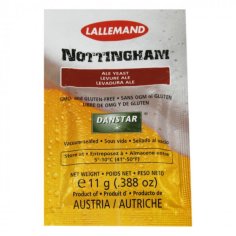
- Nottingham Ale Yeast: The Nottingham strain was selected for its highly flocculant & relatively full attenuation properties. It produces low concentrations of fruity and estery aromas and has been described as neutral for ale yeast, allowing the full natural flavour of malt & hops to develop.
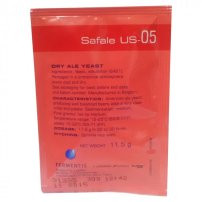 Fermentis SafAle US-05: American ale yeast producing well balanced beers with low diacetyl and a very clean, crisp end palate. Forms a firm foam head and presents a very good ability to stay in suspension during fermentation.
Fermentis SafAle US-05: American ale yeast producing well balanced beers with low diacetyl and a very clean, crisp end palate. Forms a firm foam head and presents a very good ability to stay in suspension during fermentation.
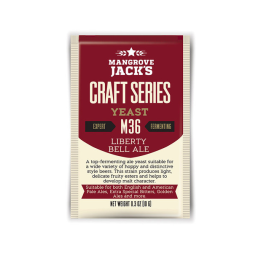 Mangrove Jack’s Craft Series Yeast Liberty Bell Ale M36: A top fermenting ale yeast suitable for a wide variety of hoppy and distinctive style beers. This strain produces light, delicate fruity esters and helps to develop malt character. Suitable for both English and American Pale Ales, Extra Special Bitters, Golden Ales and more.
Mangrove Jack’s Craft Series Yeast Liberty Bell Ale M36: A top fermenting ale yeast suitable for a wide variety of hoppy and distinctive style beers. This strain produces light, delicate fruity esters and helps to develop malt character. Suitable for both English and American Pale Ales, Extra Special Bitters, Golden Ales and more.
- WYeast Activator Ringwood Ale 1187 A top
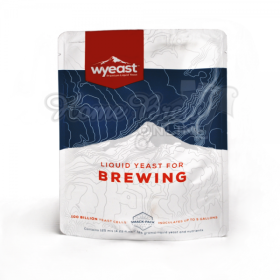
WYeast Activator Ringwood Ale 1187 cropping yeast strain with unique fermentation and flavor characteristics. Expect distinct fruit esters with a malty, complex profile. Flocculation is high, and the beer will clear well without filtration. A thorough diacetyl rest is recommended after fermentation is complete. This strain can be a slow starter and fermente
Saccharomyces Pastorianus (Lager Yeast)
This is a bottom fermenting yeast that can work at low temperatures down to about 4.4 degrees and is a close relative of S. Cerevisiae. It has also been known as Saccharomyces carlsbergensis which has caused debate in the scientific world however it’s name is now officially S. Pastorianus. This yeast was found by Emil Christian Hansen at the Carlsberg laboratory in 1883 which is possibly why for a time it bore the name S. Carlsbergensis. Here are a few examples of the lager yeasts we stock:
 WYeast Activator Pilsen Lager 2007: Wyeast 2007 is the classic American lager strain. This mild, neutral strain produces beers with a nice malty character and a smooth palate. It ferments dry and crisp with minimal sulfur or diacetyl. Beers from this strain exhibit the characteristics of the most popular lager in America.
WYeast Activator Pilsen Lager 2007: Wyeast 2007 is the classic American lager strain. This mild, neutral strain produces beers with a nice malty character and a smooth palate. It ferments dry and crisp with minimal sulfur or diacetyl. Beers from this strain exhibit the characteristics of the most popular lager in America.
- WYeast Activator Octoberfest Lager Blend
 2633 This blend of lager strains is designed to produce a rich, malty, complex and full bodied Octoberfest style beer. It attenuates well while leaving plenty of malt character and mouthfeel. This blend is low in sulfur production.
2633 This blend of lager strains is designed to produce a rich, malty, complex and full bodied Octoberfest style beer. It attenuates well while leaving plenty of malt character and mouthfeel. This blend is low in sulfur production.
- WYeast Activator Czech Pils 2278
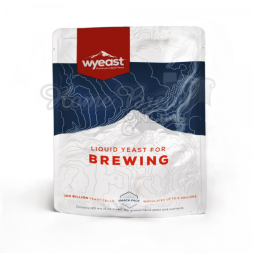 Originating from the home of great Pilsners in the Czech Republic, this classic strain will finish dry and malty. It is the perfect choice for Bohemian-style Pilsners. Sulfur produced during fermentation can be reduced with warmer fermentation temperatures 58°F (14°C) and will dissipate with conditioning.
Originating from the home of great Pilsners in the Czech Republic, this classic strain will finish dry and malty. It is the perfect choice for Bohemian-style Pilsners. Sulfur produced during fermentation can be reduced with warmer fermentation temperatures 58°F (14°C) and will dissipate with conditioning.
- Fermentis SafLager S-23
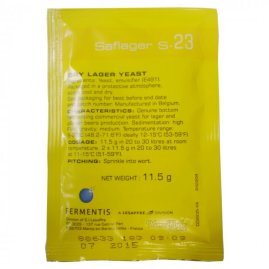 Originating from the famous VLB institute in Germany, true lager yeast capable of producing continental lagers with fruity, estery notes. Available in 11.5g sachetsBottom fermenting yeast originating from the VLB Berlin in Germany recommended for the production of fruity and estery lagers. Its lower attenuation profile gives beers with a good length on the palatte.
Originating from the famous VLB institute in Germany, true lager yeast capable of producing continental lagers with fruity, estery notes. Available in 11.5g sachetsBottom fermenting yeast originating from the VLB Berlin in Germany recommended for the production of fruity and estery lagers. Its lower attenuation profile gives beers with a good length on the palatte.
There are other yeasts used by brewers but they are not as heavily used in the UK, Brettanomyces is a Belgian style yeast and is best used in conjunction with another yeast usually Saccharomyces cerevisiae because it is pretty slow going. Torulaspora Delbrueckii is another yeast which can be used in beer making but is more commonly used in bread and baking. These yeasts were considered to be spoilage yeasts however a lot of research has gone into them to reveal that in mixed fermentations, along with Saccharomyces cerevisiae they add flavour to a beer, Brettanomyces for example will add spicy and fruity aromas. Perhaps less favourable, but each to their own, Brett can also add a barnyard aroma or ‘sweaty horse blanket’ (according to Wyeast) aroma found in Lambic beers.
Dictionary of Yeast Characteristics
Flocculation: The ability of the yeast to form clumps at the end of fermentation which then fall to the bottom of the fermenter resulting in a clear beer. Wild yeast does not flocculate well and remains suspended in the beer for a long period of time. Flocculation has been improved in brewer’s yeast over the years through human influence when brewer’s skim the yeast from the top or the bottom of the fermenter. Yeast flocculation is either high, medium or low. For example low flocculation can lead to a cloudy and yeasty tasting beer Hefeweizen yeast is a good example of this. High flocculation will generally produce a clearer beer. Flocculation is an extremely complicated process and is still the subject of much study at the moment as there are still a few mysteries to clear up.
Attenuation: This is the percentage of sugars converted by the yeast to CO2 and alcohol and gives you an idea of how different yeasts will perform. Attentuation is measured with a hydrometer by taking a start/original gravity reading, which will then proceed to fall throughout the fermentation process as the fermentable sugars are eaten up by the yeast. The final gravity (FG) reading can be used together with your original gravity (OG) to calculate the attentuation using the following equation: [(OG-FG)/(OG-1)] x 100. In order to ensure fermentation is complete take two readings over the course of 48 hours, if they remain the same this is your final gravity reading however if they change you must wait until they are stable before recording your final reading to calculate with.
Aroma: Different yeasts will add different aroma characteristics to a beer from an estery/fruity aroma to a diacetyl aroma which adds a buttery smell and flavour. Each yeast strain is different so it’s a matter of experimenting and seeing which you prefer which is all part of the fun of brewing!
Yeast in Fermentation
The fermentation process is caused by the yeast eating it’s way through the fermentable sugars turning them into CO2 and alcohol which are the waste products that yeast excretes. Once the yeast is pitched there is an initial lag phase where the yeast becomes acclimatised to it’s new home, after this it springs into action, Oxygen is a crucial element to fermentation allowing the yeast to reproduce through the process of budding where each bud produced will become a new cell. Oxygen is not used for respiration but helps in the production of new cell membranes, it is crucial to the yeast at this point. It’s worth noting that it is not possible to over aerate your wort most of it is used by the yeast and any that is left is lost from the wort in the first few hours of fermentation.
Achieving and maintaining the correct temperature with minimal fluctuation is needed for good yeast activity, if the temperature falls too far below the yeasts minimum toleration it will cause it to become dormant and if the temperature rises to far above it’s highest tolerated temperature the yeast may die so it is best to stay within the recommended temperature range of your yeast.
Yeast pitching amounts can vary depending on what type of beer you want to produce, worts with a higher gravity generally need more because they have more work to do and that work is harder. The yeast will also need to be tolerant to high levels of alcohol the Wyeast range has yeasts suitable for these types of beer such as. Wyeast recommended as a rough rule to ‘double pitch rates above 1.065 and triple pitch rates above 1.085.’ There website has a very useful question and answer page at https://wyeastlab.com/frequently-asked-questions#r24
You can see the yeast activity as the wort ferments and bubbles fizz to the surface, a frothy top of foam then forms on the surface. Eventually this foam disappears as the yeast slows down, once it has finished it then drops to the bottom of the vessel. At this point the beer will become clearer. It is best to take two hydrometer readings 48 hours apart to be sure that fermentation is complete. If the readings are stable it is fine to move onto the bottling/kegging stage however if the second reading has changed this means your wort is still fermenting and needs to be left until the two readings become the same.
The fermentation process can differ from batch to batch even if you are using the same recipe, some are vigorous and others are very quiet and do not produce any bubbles through the airlock. Many outside factors affect the speed of fermentation including temperature, amount of oxygen, amount of yeast pitched and yeast nutrient. It is always important to take hydrometer readings as this is the only true way of knowing how your fermentation is progressing.
I hope this guide has been useful if you have any further questions you can always contact us on 01904 791600 or sales@home-brew-online.co.uk. Happy Brewing!
Sources used:
http://www.whitelabs.com/resources/attenuation-and-flocculation
http://beersmith.com/blog/2008/06/18/beer-yeast-fermentation-and-home-brewing/
Little Black Dog Brew School handbook
https://byo.com/
https://en.wikipedia.org/wiki/Saccharomyces_cerevisiae
https://en.wikipedia.org/wiki/Saccharomyces_pastorianus
www.home-brew-online.com
https://www.brewersfriend.com/2009/05/30/yeast-terminology-attenuation-and-flocculation/
https://www.beeradvocate.com/beer/101/yeast/

Do you stock 4007 ?
MLF starter
LikeLike
Hello David
I’m afraid we don’t stock that particular one but we will look into putting it on our next order.
Best Regards
Lisa
LikeLike
Do you stock 4007?
LikeLike
Got any Kveik?
(Almost didn’t dare asking…)
LikeLike
I’m afraid not, sorry. I’ve checked online and it’s a bit elusive but I’ll keep my eye out to see whether we can stock it at some point in the future.
LikeLike